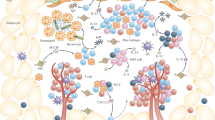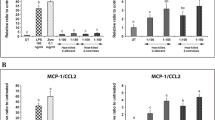Abstract
In addition to the well-known role of adipose tissue in energy metabolism, it has recently been demonstrated that this tissue can secrete a large array of molecules, including inflammatory cytokines. Furthermore, recent studies suggest that adipose cells can behave as immune cells. Therefore, the aim of this study was to determine the presence of the two most prominent ‘pattern recognition receptors’ for bacterial and fungal cell wall components, TLR2 and TLR4 on human adipose cells, as well as to assess their functionality. We demonstrated that TLR2 and TLR4 were expressed at relatively high levels (compared to a monocyte cell line) on the surface of human adipose cells. Stimulation of human adipocytes with lipopolysaccharide (LPS), or with lipoteichoic acid (LTA), two specific ligands of TLR4 and TLR2, respectively, induced a strong increase in TNFα production. The specificity of the response was demonstrated by the use of anti-TLR4 and anti-TLR2 blocking antibodies, which were able to decrease LPS- or LTA-induced TNFα secretion. Thus, it is clear that these receptors are functional in human adipocytes. This study adds weight to the argument that human fat tissue plays a potential role in innate immunity.




Similar content being viewed by others
References
Beutler B (2004) Innate immunity: an overview. Mol Immunol 40:845–859
Beutler B, Du X, Poltorak A (2001) Identification of Toll-like receptor 4 (Tlr4) as the sole conduit for LPS signal transduction: genetic and evolutionary studies. J Endotoxin Res 7:277–280
Bochsler PN, Yang Z, Murphy CL, Carroll RC (1996) Purification of lipopolysaccharide-binding protein from bovine serum. Vet Immunol Immunopathol 51:303–314
Dong Z, Yang Z, Wang C (2005) Expression of TLR2 and TLR4 messenger RNA in the epithelial cells of the nasal airway. Am J Rhinol 19:236–239
Ellingsen E, Morath S, Flo T, Schromm A, Hartung T, Thiemermann C, Espevik T, Golenbock D, Foster D, Solberg R, Aasen A, Wang J (2002) Induction of cytokine production in human T cells and monocytes by highly purified lipoteichoic acid: involvement of Toll-like receptors and CD14. Med Sci Monit 8:BR149–BR156
Festy F, Hoareau L, Bes-Houtmann S, Pequin AM, Gonthier MP, Munstun A, Hoarau JJ, Cesari M, Roche R (2005) Surface protein expression between human adipose tissue-derived stromal cells and mature adipocytes. Histochem Cell Biol 1–9
Gangloff SC, Zahringer U, Blondin C, Guenounou M, Silver J, Goyert SM (2005) Influence of CD14 on ligand interactions between lipopolysaccharide and its receptor complex. J Immunol 175:3940–3945
Hotamisligil GS, Arner P, Caro JF, Atkinson RL, Spiegelman BM (1995) Increased adipose tissue expression of tumor necrosis factor-alpha in human obesity and insulin resistance. J Clin Invest 95:2409–2415
Iwamoto M, Kurachi M, Nakashima T, Kim D, Yamaguchi K, Oda T, Iwamoto Y, Muramatsu T (2005) Structure-activity relationship of alginate oligosaccharides in the induction of cytokine production from RAW264.7 cells. FEBS Lett 579:4423–4429
Jones BW, Heldwein KA, Means TK, Saukkonen JJ, Fenton MJ (2001) Differential roles of Toll-like receptors in the elicitation of proinflammatory responses by macrophages. Ann Rheum Dis 60(Suppl 3):iii6–12
Kitchens RL, Thompson PA (2005) Modulatory effects of sCD14 and LBP on LPS-host cell interactions. J Endotoxin Res 11:225–229
Lemaitre B, Nicolas E, Michaut L, Reichhart JM, Hoffmann JA (1996) The dorsoventral regulatory gene cassette spatzle/Toll/cactus controls the potent antifungal response in Drosophila adults. Cell 86:973–983
Lin Y, Lee H, Berg AH, Lisanti MP, Shapiro L, Scherer PE (2000) The lipopolysaccharide-activated toll-like receptor (TLR)-4 induces synthesis of the closely related receptor TLR-2 in adipocytes. J Biol Chem 275:24255–24263
Medzhitov R, Preston-Hurlburt P, Janeway CA Jr (1997) A human homologue of the Drosophila Toll protein signals activation of adaptive immunity. Nature 388:394–397
Miller LS, Sorensen OE, Liu PT, Jalian HR, Eshtiaghpour D, Behmanesh BE, Chung W, Starner TD, Kim J, Sieling PA, Ganz T, Modlin RL (2005) TGF-alpha regulates TLR expression and function on epidermal keratinocytes. J Immunol 174:6137–6143
Miner JL (2004) The adipocyte as an endocrine cell. J Anim Sci 82:935–941
Moreno MJ, Martinez JA (2002) Adipose tissue: a storage and secretory organ. An Sist Sanit Navar 25(Supp l1):29–39
Muzio M, Mantovani A (2001) Toll-like receptors (TLRs) signalling and expression pattern. J Endotoxin Res 7:297–300
Paik YH, Schwabe RF, Bataller R, Russo MP, Jobin C, Brenner DA (2003) Toll-like receptor 4 mediates inflammatory signaling by bacterial lipopolysaccharide in human hepatic stellate cells. Hepatology 37:1043–1055
Parker LC, Whyte MK, Vogel SN, Dower SK, Sabroe I (2004) Toll-like receptor (TLR)2 and TLR4 agonists regulate CCR expression in human monocytic cells. J Immunol 172:4977–4986
Pivarcsi A, Kemeny L, Dobozy A (2004) Innate immune functions of the keratinocytes. A review. Acta Microbiol Immunol Hung 51:303–310
Saillan-Barreau C, Cousin B, Andre M, Villena P, Casteilla L, Penicaud L (2003) Human adipose cells as candidates in defense and tissue remodeling phenomena. Biochem Biophys Res Commun 309:502–505
Schroder NW, Morath S, Alexander C, Hamann L, Hartung T, Zahringer U, Gobel UB, Weber JR, Schumann RR (2003) Lipoteichoic acid (LTA) of Streptococcus pneumoniae and Staphylococcus aureus activates immune cells via Toll-like receptor (TLR)-2, lipopolysaccharide-binding protein (LBP), and CD14, whereas TLR-4 and MD-2 are not involved. J Biol Chem 278:15587–15594
Sewter CP, Digby JE, Blows F, Prins J, O’Rahilly S (1999) Regulation of tumour necrosis factor-alpha release from human adipose tissue in vitro. J Endocrinol 163:33–38
Shubinsky G, Schlesinger M (1997) The CD38 lymphocyte differentiation marker: new insight into its ectoenzymatic activity and its role as a signal transducer. Immunity 7:315–324
Siedlar M, Szczepanik A, Wieckiewicz J, Pituch-Noworolska A, Zembala M (1997) Vancomycin down-regulates lipopolysaccharide-induced tumour necrosis factor alpha (TNF alpha) production and TNF alpha-mRNA accumulation in human blood monocytes. Immunopharmacology 35:265–271
Skurk T, Kolb H, Muller-Scholze S, Rohrig K, Hauner H, Herder C (2005) The proatherogenic cytokine interleukin-18 is secreted by human adipocytes. Eur J Endocrinol 152:863–868
Takeda K, Akira S (2001) Regulation of innate immune responses by Toll-like receptors. Jpn J Infect Dis 54:209–219
Takeda K, Akira S (2005) Toll-like receptors in innate immunity. Int Immunol 17:1–14
Tedder TF, Streuli M, Schlossman SF, Saito H (1988) Isolation and structure of a cDNA encoding the B1 (CD20) cell-surface antigen of human B lymphocytes. Proc Natl Acad Sci USA 85:208–212
Villena JA, Cousin B, Penicaud L, Casteilla L (2001) Adipose tissues display differential phagocytic and microbicidal activities depending on their localization. Int J Obes Relat Metab Disord 25:1275–1280
Visintin A, Mazzoni A, Spitzer JH, Wyllie DH, Dower SK, Segal DM (2001) Regulation of Toll-like receptors in human monocytes and dendritic cells. J Immunol 166:249–255
Yang Z, Breider MA, Carroll RC, Miller MS, Bochsler PN (1996) Soluble CD14 and lipopolysaccharide-binding protein from bovine serum enable bacterial lipopolysaccharide-mediated cytotoxicity and activation of bovine vascular endothelial cells in vitro. J Leukoc Biol 59:241–247
Acknowledgments
We are grateful to patient volunteers and reconstructive surgery departments (CHD Félix Guyon, Saint-Denis) for supplying adipose tissue. This work was supported by grants from the Ministère de l’Outre Mer, Ministère de l’Enseignement Supérieur et de la Recherche, and the Conseil Régional de La Réunion. We would like to thank the plastic surgeons J. F. Baron, P. Delarue and J. Gonçalves who took part in this study and allowed the collection of subcutaneous adipose tissue samples.
Author information
Authors and Affiliations
Corresponding author
Additional information
Sandrine Bés-Houtmann, Régis Roche, Christian Lefebvre d’Hellencourt and Maya Cesari have contributed equally to this work.
Rights and permissions
About this article
Cite this article
Bès-Houtmann, S., Roche, R., Hoareau, L. et al. Presence of functional TLR2 and TLR4 on human adipocytes. Histochem Cell Biol 127, 131–137 (2007). https://doi.org/10.1007/s00418-006-0230-1
Accepted:
Published:
Issue Date:
DOI: https://doi.org/10.1007/s00418-006-0230-1




